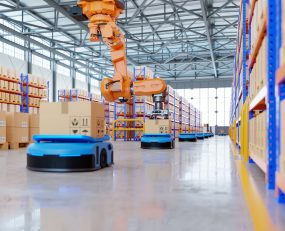
Tom Anderson – principal Analyst and Co-founder of market research publisher Styleintelligence – answers our questions on robotics and automation (R&A) in the UK warehouse sector. Kirsty Adams, Head of Media Content, Ti Insights.
Kirsty Adams (KA): What is the most advanced robotics and automation on the market?
Tom Anderson (TA): I don’t think it’s so much about advanced, but rather products that work without breaking down frequently or needing much maintenance.
Many of the startups in the sector have matured and become far more reliable. In the early days (about five years ago) there was a lot of talk about batteries overheating. But we haven’t heard of this recently. If we can say that this maturity and reliability is a new level of ‘advanced Robotics and Automation,’ then that’s a good thing.
Another aspect is that we didn’t see a lot of new ground-breaking innovation in the sector in 2022. It felt like the sector consolidated after a couple of very hectic and volatile years. We expect to see some more innovation on the market in 2023 and 2024. There has already been a few interesting new companies like Fulfil and Mytra emerging from stealth in early 2023.
KA: Has anything surprised you in the R&A sector recently?
TA: Perhaps not recently, but how people behave when they are around robots and automation – it seems many of us are not very comfortable. Perhaps there needs to be more research around how humans behave around robots? Or robot designers need to be more aware of it, and take it into account when deploying robots and people in the same environment.
Fire safety is becoming a much more important issue as there has been stricter guidance recently, especially since the Ocado warehouse fire. When buying automation solutions you need to be aware of the fire guidance so you can actually get insurance cover for your business.
We have also heard this affects existing installations. This is now a core aspect of any procurement process, and buyers should be aware of requirements as they may affect their insurance premiums.
KA: Are warehouse operators investing in automation?
TA: Automation customers, especially retailers, have become a bit more cautious and are pushing investments decisions further forward to get more clarity. There are plenty of conflicting indicators and no one really seems to understand the post-pandemic economy very well.
People talk about recession, but at the same time unemployment is at record lows. Inflation is not coming down significantly and energy bills are huge. These conflicting signals are pushing many potential customers to postpone investments until they have a bit more data.
KA: What impact are energy price hikes having on the implementation/operation of robotics and automation?
TA: Energy prices have not been a huge factor for automation buyers, but it doesn’t mean it’s not part of the equation. A few automation vendors have added energy recovery into their solutions. For example, a lift that moves down may use a recovery system to break the lift movement and add some charge to batteries instead. However, there is always a cost with such solutions and each buyer needs to make an ROI calculation to get to the bottom if this is useful for them or not.
KA: What should every UK warehouse operator know regarding R&A in 2023?
TA: Firstly, the width of solutions available to them and the efficiency they may provide. We publish a range of free market research reports that can be a useful start when researching potential vendors: https://www.styleintelligence.com/collections/the-reports
Secondly, R&A is only a part of a company’s tool bag. Understanding the company strategy and converting that into a procurement project is a task in itself. However large or small a project, identifying a project manager with some experience in buying automation is essential to avoid problems further down the line.
It’s worth remembering that your manual forklift driver may do many small things that a robot will simply not do, such as removing extruding pieces of a chipped pallet or pallet wrapping that’s hanging down on the floor, and so on.
It’s important to understand what you are doing today as a potential customer of automation, and how to translate that into an automated solution. Understanding the limitations and advantages of robots and automation can often be difficult, especially when listening to sales people.
Styleintelligence publishes high quality and unbiased market reports which focus on the industry vector stretching from retail, retail technology to warehouse automation and industry 4.0
Supply chain strategists can use GSCi – Ti’s online data platform – to identify opportunities for growth, support strategic decisions, help them stay abreast of industry trends and development, as well as understand future impacts on the industry.
Visit GSCI subscription to sign up today or contact Michael Clover for a free demonstration: [email protected] | +44 (0) 1666 519907